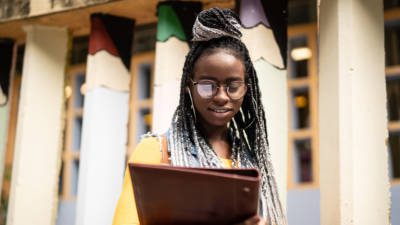Work-study can help you pay for necessities during college and prepare you for the future.
What is Work-Study?
The Federal Work-Study Program is a form of financial aid that is awarded to students based on need and enables students to earn money through a part-time job. You receive the money as a paycheck, and the money is typically used for living expenses while in college. You don’t need to provide itemization of how your federal work-study money is used.
Work-study is not guaranteed money, and you’re not guaranteed a job in your financial aid package. You’ll still need to apply and interview for positions, and your actual pay will be determined by the job you get. Most jobs are on campus, but there are some off-campus jobs as well including community service and non-profit options. Your financial aid office or your career development office are good places to look for opportunities that best suit you.
Work-Study and the FAFSA®
The money you make from work-study does not impact your financial aid package. However, the amount you work can’t exceed your overall work-study award, and you may have additional limitations on hours you work depending on your class schedule and progress.
You can also look for off-campus jobs that aren’t connected to work-study. Be aware that those earnings may impact your financial aid award each year if they exceed the Income Protection Allowance (IPA). The good news is that the IPA amount does increase each year. For example, a dependent student’s IPA has increased by about 35% for the 2024-25 FAFSA, compared to the prior year.
A work-study position can be more than just a clock-in and clock-out situation. It can be rewarding, eye-opening, and fun. It’s also an opportunity to get experience in a field where you see your future career. For some students, their work-study jobs turn out to be a highlight of their time in college. Oscar Martinez is a high school counselor at IDEA Weslaco College Preparatory and attributes his career success to his work-study program at Texas A&M University. Here, Martinez shares why his job was such a key part of his education, plus his advice for other students who are choosing which options might be the best fit for them.
How One Student Maximized His Work-Study Experience
As a freshman at Texas A&M University, I was placed into my first work-study position in the Visitor’s Center Marketing and Communications Department. I was a tour guide, and my responsibilities included touring prospective students around campus and helping them understand what going to school at Texas A&M was like. I found it incredibly rewarding to answer questions about campus life, the admissions process and financial aid. I enjoyed it a lot and realized I wanted to do it for more than just a few hours a week.
After a year of tour guiding, I segued into a work-study role that offered more hours as a peer counselor at the Office of Scholarships and Financial Aid—a job I kept until graduation. I got formal training as a financial aid counselor and became an expert in helping students understand the ins and outs of financing their education. Most of my time was spent on the phone, answering questions regarding financial aid, scholarships, and work-study. We would also see walk-ins, go through students’ paperwork, and solve problems to help students get as much funding as possible for their education.
My peer counselor work-study position ended when I graduated, but the Office of Scholarships and Financial Aid actually hired me full-time and gave me a place to launch my career in education. Without my work-study experience in the office, I doubt I would have nabbed that entry-level job and found myself on this career path. Eventually, I moved to San Antonio to work at the University of Texas at San Antonio as an admissions officer. Admissions officers need to have a solid base of knowledge in financial aid and scholarship opportunities because paying for college is a major concern for prospective students. The years I spent as a work-study student and employee of A&M’s Office of Scholarships and Financial Aid proved to be a huge benefit to me when I was out on the road recruiting students and answering questions.
Now, I’m a high school counselor at IDEA Weslaco College Preparatory, where I still use the skills I first began to develop as a work-study tour guide and peer counselor. I help students through the college admissions process and answer questions about financial aid and scholarships, just like I did as a peer counselor. This job is a dream come true for me, and it’s exactly where I want to be.
I was very fortunate to end up in that first work-study position as a tour guide. It started a chain of events that led to this awesome career that I love. My second work-study role as a peer counselor taught me important problem-solving skills and opened my eyes to the field of higher education. I was a political science major as an undergraduate, and I would have never found this career path had it not been for my work-study jobs.
I’d recommend trying to find a work-study job that aligns with your future career interests. If that’s not possible or if you don’t know what you want to do, the skills you learn from your work-study can probably be applied to several different types of careers, or at least the job will be a topic of conversation in future interviews. Work-study jobs can definitely be more than just jobs if you try to squeeze the most benefit and learning out of the experience.
FAFSA® is a registered trademark of the US Department of Education and is not affiliated with Discover® Student Loans.




